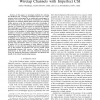Free Online Productivity Tools
i2Speak
i2Symbol
i2OCR
iTex2Img
iWeb2Print
iWeb2Shot
i2Type
iPdf2Split
iPdf2Merge
i2Bopomofo
i2Arabic
i2Style
i2Image
i2PDF
iLatex2Rtf
Sci2ools
CORR
2010
Springer
2010
Springer
Robust Beamforming for Security in MIMO Wiretap Channels with Imperfect CSI
—In this paper, we investigate methods for reducing the likelihood that a message transmitted between two multiantenna nodes is intercepted by an undetected eavesdropper. In particular, we focus on the judicious transmission of artificial interference to mask the desired signal at the time it is broadcast. Unlike previous work that assumes some prior knowledge of the eavesdropper’s channel and focuses on maximizing secrecy capacity, we consider the case where no information regarding the eavesdropper is available, and we use signal-to-interferenceplus-noise-ratio (SINR) as our performance metric. Specifically, we focus on the problem of maximizing the amount of power available to broadcast a jamming signal intended to hide the desired signal from a potential eavesdropper, while maintaining a prespecified SINR at the desired receiver. The jamming signal is designed to be orthogonal to the information signal when it reaches the desired receiver, assuming both the receiver and the ...
| Added | 24 Jan 2011 |
| Updated | 24 Jan 2011 |
| Type | Journal |
| Year | 2010 |
| Where | CORR |
| Authors | Amitav Mukherjee, A. Lee Swindlehurst |
Comments (0)

